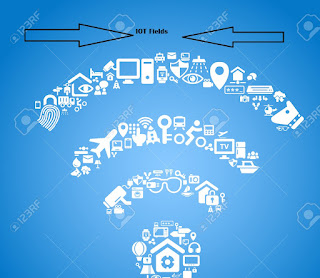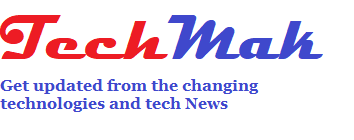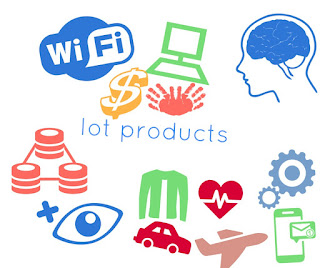Internet Of Things(IoT):-
 |
| IOT Uses in the different fields |
The Internet is the most used things in the 21st century.
The Internet of Things ( IoT ) is a system of crowning computing devices, mechanical and digital machines, objects, people or animals that are provided with individual identifiers and the ability to transfer data over a network without the involvement of human-to-human or human to computer interaction.
A network of Internet-connected devices is able to collect and exchange data using embedded sensors or the artificial machines.
Points to be covered in this article:-
1. Introduction of IOT
2. History of IOT
3.Working of IOT
4.Application of IOT
5.Drawbacks of IOT
6.Conclusion
Introduction to IOT:-
The lay to an internet of things ( IoT ) is that the internetworking of physical devices, applications, buildings, vehicles, housing automating devices and alternative Objects embedded with physics, software, sensors and network property that allows these devices to gather, exchange and transfer information and also the helpful data. It also includes Artificial intelligence and digital footprint.
The IoT(internet of things) allows devices or objects to be sensed or controlled remotely across existing network infrastructure. It is one of the very hot topics in the nowadays professional industry, marketing industry, policy and also in engineering circles. This technology is connected with a large chromatic of networked products, devices, applications, system, and sensors, which takes advantage of advances in computing power and network interconnection. This feature enhances the compatibility of the IoT devices uses in daily life.
The IoT(internet of things) allows devices or objects to be sensed or controlled remotely across existing network infrastructure. It is one of the very hot topics in the nowadays professional industry, marketing industry, policy and also in engineering circles. This technology is connected with a large chromatic of networked products, devices, applications, system, and sensors, which takes advantage of advances in computing power and network interconnection. This feature enhances the compatibility of the IoT devices uses in daily life.
History of IOT:-
The term internet of things ( IoT ) is around 17 years old concept. But this is ancient technology, which has been introduced in 70's era. That time IoT was called as "embedded internet" or " pervasive computing."
The term IoT was firstly taken by Kevin Ashton in 1999 during his work as Proctor and gambler. He was a British technology pioneer who was working on RFID ( Radio Frequency Identification). As the internet was the hottest new trend in 1999, he used these technologies in supply chain optimization in his business.
IoT started to gain some popularity in the summer of 2010. In October of 2013, IDC published a report stating that the internet of things would be an $8.9 trillion business market in 2020.
The first IoT device an IP ( internet protocol) enabled toaster that could be turned on or off with the internet was introduced at an internet conference in 1990.
The term IoT was firstly taken by Kevin Ashton in 1999 during his work as Proctor and gambler. He was a British technology pioneer who was working on RFID ( Radio Frequency Identification). As the internet was the hottest new trend in 1999, he used these technologies in supply chain optimization in his business.
IoT started to gain some popularity in the summer of 2010. In October of 2013, IDC published a report stating that the internet of things would be an $8.9 trillion business market in 2020.
The first IoT device an IP ( internet protocol) enabled toaster that could be turned on or off with the internet was introduced at an internet conference in 1990.
Working of IOT:-
LI-FI is also one of the examples of a use of IOT.
Now we will know about the concept that how IoT works. I have categorized the working principle of IoT in following steps:-
1. Define the objective of application:-
This is the preliminary step related to starting any IoT application. We should know the basics connected to the devices that for which purpose this method will be used.
2. Build IoT network and security foundation:-
Many industrial IoT deployments have used proprietary networks. Instead of building proprietary systems, IT should connect IoT devices with standards-based IP networks. An IP-based network will help businesses deliver the performance, reliability, and interoperability that are required to support global IoT networks and connections with partner ecosystems.
3. Collect all relevant data:-
Businesses that don't plan carefully for IoT will be affected by the volume and variety of data that IoT will generate. While each sensor may only produce a small amount of data, a company will be collecting data from thousands to millions of sensors. To create a fully automated IoT application or device we should know about the sensors and the related devices which are being used.
4. Review the size and scale of application:-
We have to keep track of the size and scale of the devices we are making because it is the primary stage of the price determining of the IoT product. The methods generated should be more optimal than the currently available devices, then only some transparency in the market which is gained.
Application of IOT:-
 |
| IOT applications |
1. Smart Homes:-
Smart Home clearly stands out, ranking as the highest Internet of Things application on all measured channels. More than 60,000 people currently search for the term 'Smart Home' each month. This is not a surprise. Smart homes include security and all other related facilities. Smart homes have bought a revolutionary change in the lifestyle of humans. Everyone nowadays wants to be updated with the new trending technologies.
2. Smart City:-
The smart city spans a wide variety of use cases, from traffic management to water distribution, to waste management, urban security, and environmental monitoring. Its popularity is fueled by the fact that many Smart City solutions promise to alleviate real pains of people living in cities these days. IoT solutions in the area of Smart City solve traffic congestion problems, reduce noise and pollution and help make cities safer. A smart city is a dream of developing country like India. They are growing like some of the towns are using the IoT application.
3. Industrial Internet:-
The industrial internet is also one of the first Internet of Things applications. While many market research such as Gartner or Cisco sees the industrial internet as the IoT concept with the highest overall potential, its popularity currently doesn't reach the masses like smart home do. The industrial internet, however, has a lot going for it. The industrial internet gets the most significant push of people on Twitter (~1,800 tweets per month) compared to other non-consumer-oriented IoT concepts. The industry also wants to be updated with the new technologies so to be competitive in the market.
4.Smart Farming:-
4.Smart Farming:-
Smart farming is an often overlooked business-case for the internet of Things because it does not really fit into the popular categories such as health, mobility, or industrial. However, due to the remoteness of farming operations and the large number of livestock that could be monitored the Internet of Things could revolutionize the way farmers work. But this idea has not yet reached large-scale attention. Nevertheless, one of the Internet of Things applications that should not be underestimated. Smart farming will become the critical application field in the predominantly agricultural-product exporting countries.
Smart farming includes new techniques to increase the productivity of fields. Growing of hybrid seeds is one of the examples of it.
Smart farming includes new techniques to increase the productivity of fields. Growing of hybrid seeds is one of the examples of it.
Drawbacks of IOT:-
As we know that every technology has some advantage and disadvantage. In this section, we are going to discuss the problems of the internet of things.
Following are the some of the disadvantages of IoT:-
1. Compatibility:-
Currently, there is no international standard of compatibility for the tagging and monitoring equipment. I believe this disadvantage is the easiest to overcome.
Following are the some of the disadvantages of IoT:-
1. Compatibility:-
Currently, there is no international standard of compatibility for the tagging and monitoring equipment. I believe this disadvantage is the easiest to overcome.
2. Complexity:-
As we know that there are significant changes to be the failure of the internet of things devices, with the increasing loads or the heavy users. So this increases the complexity of the applications regarding time and space.
3.Privacy and Security:-
With all of this IoT data being transmitted, the risk of losing privacy increases. For instance, how well encrypted will the information be kept and transferred with? Do you want your neighbors or employers to know what medications that you are taking or your financial situation?
As we know that there are significant changes to be the failure of the internet of things devices, with the increasing loads or the heavy users. So this increases the complexity of the applications regarding time and space.
With all of this IoT data being transmitted, the risk of losing privacy increases. For instance, how well encrypted will the information be kept and transferred with? Do you want your neighbors or employers to know what medications that you are taking or your financial situation?
Conclusion:-
So, I have discussed pros and cons of the IoT( internet of things).The Internet Society cares about IoT because it epitomizes an expanding aspect of how people and institutions are likely to collaborate with and incorporate the Internet and network connectivity into their personal, social, and economic lives. Solutions to maximizing the benefits of IoT while minimizing the risks will not be found by engaging in a polarized debate that pits the promises of IoT against its possible perils. Instead, it will take informed engagement, dialogue, and collaboration across a range of stakeholders to plot the most effective ways forward.
--------------------------------------------------------------------------------------------


0 comments:
Post a Comment